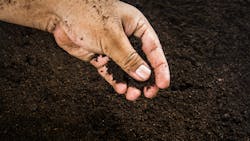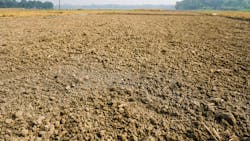Soil pH, organic matter & texture: The key factors for successful vegetation establishment
The importance of soil properties when trying to establish vegetation for erosion control is crucial because they can affect the success of the vegetation. Sustainable vegetation is the best form of erosion control because it helps prevent soil erosion and provides long-term stability. So, what is the importance of soil properties when trying to establish vegetation for erosion control? Soil properties such as pH, organic matter, and soil structure (sand, silt, clay) can affect the growth of vegetation. For example, if the pH is too low or too high, it can affect the availability of nutrients that vegetation needs to grow. Similarly, if the soil structure is too compacted or too loose, it can affect the ability of roots to grow and absorb water and nutrients. The goal on every project site should be to leave the site in better condition than upon arrival. Creating sustainable vegetation for erosion control will help bring success in that endeavor.
Understanding soil samples
It is important to take soil samples and look at the soil properties before seeding to ensure the right amendments are added to the soil. A blanket soil amendment solution for every site does not exist. It is like going to the doctor complaining about a stomachache and the doctor says, “Well, time for a triple bypass!” without even checking the patient’s pulse. It does not make a lot of sense and neither does trying to establish vegetation without a soil test.
Often, if a contractor has tried to establish vegetation that came in spotty and is asked “Did you do a soil test?” the response is usually “No, I put down lime and triple 19, like I’ve always done.” Just because topsoil looks dark and rich does not mean it is a great topsoil. It still needs to be tested. Taking soil samples and looking at the results can determine what amendments are needed for a specific site. Let’s focus on a couple key components of a soil report to review when trying to establish sustainable vegetation.
Soil pH is an important factor that can affect the activation of fertilizers by altering the availability of many nutrients. It also affects the activity of soil microbes. To establish vegetation, the pH range should be between 6.3 and 7.3 to have a positive effect on the availability of nutrients in the soil. Depending on where the pH level is, it may need to be adjusted. There are numerous ways to raise and lower pH levels. The most common application to raise pH is agricultural lime. Agricultural lime tends to take a long time to activate. The finer the lime particles, the quicker it becomes effective. There are fast-acting limes out there. Often, it is recommended to use both a fast-acting and agricultural lime to get the best results. Calcium will help raise pH as well. A couple of common ways to lower the soil pH are elemental sulfur and gypsum.
Examining organic matter
Organic matter is another crucial factor that can help establish sustainable vegetation. High organic matter in soil has many benefits, including an increase in water retention, helping with the soil bacterial community structure and capturing carbon. Typically, organic matter should be 5% or higher for establishing vegetation, and most of the soil life and root system is in the top 4 to 6 inches of soil.
There are different ways to increase organic matter when establishing sustainable vegetation. In the agricultural industry, manure is often used for this purpose, however this is not a common practice on construction sites. Compost, when made properly, has been successfully used on many project sites. Biotic soil amendments have been used with great results to increase organic matter year over year. There are many organic fertilizers that help with increasing organic matter, so do some research when looking at the different options available.
Looking at texture
Soil structure is made of looking at the sand, silt and clay percentage. Sand should be in the range of 20 to 60%, and the silt and clay should make up 40 to 80%. Depending on the region, this can vary greatly. In the northeast, a fair number of samples come back with 80 to 90% sand content. It is very difficult to have moisture retention with that high of a percentage of sand. This high percentage of sand usually goes hand in hand with low organic matter. In the northeast, we do not see a high concentration of silt or clay in the soils, but when these projects do arise, the soil is typically compacted. Where sandy soils do not hold much moisture, compacted soils do not have a lot of room for air. Basic soil components are minerals, organic matter, water and air.
When attempting to vegetate a slope with a high sand content, there are some challenges. As an example, recently, a project’s soil sample results came back with 1.1% organic matter and 94.8% sand. The site was a 3:1 slope with a downhill run of 1,500 feet. The contractor’s plan was to broadcast spread a conservation seed mix, then cover it with straw. The result was scattered weeds and large washouts after a simple rain event. Had the contractor created a plan for amending the soil based on the results of a soil test, they would have had a higher percentage of sustainable vegetation. The project team should bring in a topsoil or loam sample, test it and make a plan for how to amend the soil.
Conclusion
Establishing sustainable vegetation for erosion control requires understanding the soil and adding the right amendments. To ensure vegetation thrives year after year, it is important to do some research, ask questions, and seek out a specialist. Protecting seed is also important. The key is to create the best opportunity for sustainable vegetation by taking soil samples, looking at the results, and asking questions about the best options for amending that soil.



